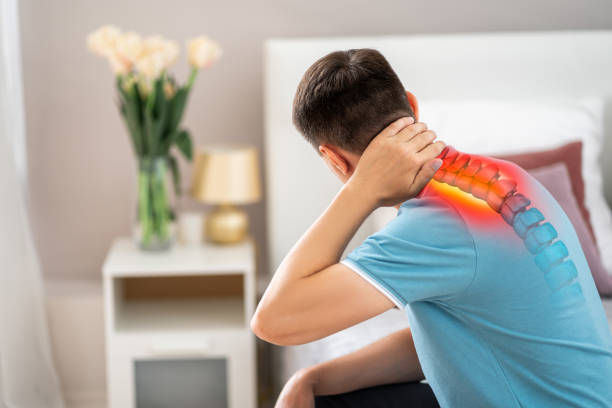Common Spine Conditions
- Napier Spine
- Oct 17, 2024
- 4 min read

The spine is a crucial part of the human body, supporting movement, flexibility, and strength. Spine conditions, however, can severely impact quality of life and cause significant discomfort or disability. Understanding the common conditions that affect the spine can help in early detection and proper treatment.
1. Herniated Disc
A herniated disc occurs when the soft, gel-like center of a spinal disc pushes through a tear in the outer layer. This condition often leads to pain, numbness, or weakness, especially when the disc presses on nearby nerves. Herniated discs can develop due to age-related wear and tear, or from traumatic injuries like lifting heavy objects improperly.
Treatment options vary depending on severity, but they typically include rest, physical therapy, pain management, or surgery in extreme cases. Minimally invasive procedures are also available for patients who require more intensive intervention.
2. Degenerative Disc Disease
As people age, spinal discs naturally lose hydration and elasticity, which can lead to degenerative disc disease. The condition may cause chronic back pain, radiating discomfort to the limbs, or restricted movement. It can develop from prolonged wear and tear or injury.
Initial treatment often focuses on non-surgical options like physical therapy, medications, or lifestyle changes. Surgery, such as spinal fusion or artificial disc replacement, might be recommended in advanced cases.
3. Spinal Stenosis
Spinal stenosis refers to the narrowing of spaces within the spine, which puts pressure on the nerves traveling through the spinal cord. This condition is commonly caused by osteoarthritis or the degeneration of discs and vertebrae, leading to symptoms such as pain, tingling, numbness, and muscle weakness.
Conservative treatments like physical therapy and medication may provide relief, but severe cases could require surgical interventions to decompress the nerves.
4. Scoliosis
Scoliosis is a curvature of the spine that often develops during adolescence. While mild cases may not require treatment, more severe curvatures can lead to pain, reduced lung capacity, and difficulties with movement.
Treatment depends on the degree of the curve and the patient's age. Bracing is common for children, while surgery may be recommended for adults with severe or worsening curvature.
5. Sciatica
Sciatica is characterized by pain radiating along the sciatic nerve, which runs down one or both legs from the lower back. It is typically caused by a herniated disc, spinal stenosis, or other conditions that compress the nerve roots. Symptoms include sharp pain, burning sensations, and weakness in the affected leg.
Many sciatica cases improve with conservative treatment, such as physical therapy, anti-inflammatory medications, and stretches. In more severe cases, surgery might be needed to relieve pressure on the sciatic nerve.
6. Spondylolisthesis
Spondylolisthesis occurs when one vertebra slips forward over the vertebra below it. This condition can cause back pain, leg pain, and muscle stiffness. It may be due to congenital defects, trauma, or degenerative changes in the spine.
Treatment includes physical therapy, pain management, or, in severe cases, spinal fusion surgery to stabilize the affected vertebrae.
7. Osteoporosis and Compression Fractures
Osteoporosis is a condition that weakens bones, making them more susceptible to fractures. Compression fractures in the spine occur when vertebrae collapse due to weakened bone structure, leading to pain, loss of height, and deformity.
Treatment for osteoporosis often involves medications to strengthen bones, along with physical therapy. Compression fractures might require bracing or procedures like vertebroplasty or kyphoplasty to stabilize the spine.
8. Kyphosis
Kyphosis is an excessive outward curvature of the spine, which can lead to a hunched back. It may result from poor posture, osteoporosis, or congenital issues. Mild cases might not require intervention, but more severe cases can cause pain and breathing difficulties.
Treatment may include physical therapy to strengthen muscles, bracing, or surgery to correct the curve.
9. Ankylosing Spondylitis
Ankylosing spondylitis is a type of inflammatory arthritis that primarily affects the spine and sacroiliac joints. It leads to stiffness, pain, and potentially fusion of the vertebrae, causing reduced mobility.
Treatment focuses on reducing inflammation with medications, physical therapy, and, in advanced cases, surgery to restore mobility.
10. Cauda Equina Syndrome
Cauda equina syndrome is a medical emergency caused by severe compression of the nerve roots in the lower spine. Symptoms include loss of bladder or bowel control, severe pain, and numbness in the legs.
Immediate surgical intervention is required to relieve pressure on the nerves and prevent permanent damage.
Conclusion
Spinal conditions range widely in severity and treatment, from mild discomfort to severe pain requiring surgery. Early diagnosis and appropriate treatment are vital to manage symptoms and prevent long-term issues. If you experience symptoms such as chronic back pain, numbness, or weakness, it’s important to consult a specialist who can recommend the best course of action for your condition. For more details, go to the source: https://www.napierspine.com/ to explore options and find expert guidance on spine health.
FAQs
1. Can spinal conditions be treated without surgery?
Yes, many conditions can be managed with physical therapy, medication, and lifestyle changes. Surgery is typically a last resort.
2. How can I prevent spine problems?
Maintaining a healthy weight, staying active, practicing good posture, and avoiding heavy lifting can help prevent spine issues.
3. What is the recovery time for spinal surgery?
Recovery depends on the type of surgery and the individual's health. It can range from a few weeks to several months.
4. Is physical therapy effective for spinal conditions?
Yes, physical therapy is often a key component of non-surgical treatment plans for various spine conditions.
5. When should I see a spine specialist?
If you experience persistent back or neck pain, numbness, or weakness, it's important to consult a spine specialist for evaluation.



Comments